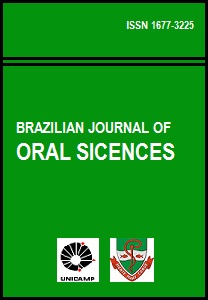Abstract
Aim: To evaluate the influence of saliva contamination on the short- and long-term bond strength of a self-etch adhesive system. Methods: One hundred and twelve non-carious human molars were randomly divided according to: substrate (enamel/dentin); presence of saliva [none (controlC), before primer (BP), after primer (AP) and after bonding agent (AB)]; treatment of the contamination [none (1), rinsing + drying (2), drying (3) and primer re-application (4)] and specimen storage (24 h or 6 months). A self-etch adhesive system was applied to the dental surfaces followed by incremental insertions of composite resin. After storage in water at 37o C, the specimens were perpendicularly cut into beams for microtensile bond strength testing. Data in MPa were compared by ANOVA followed by Tukey’s test (p< 0.05). Micrographs were obtained by low vacuum scanning electron microscopy. Results: Control groups (G1 and G8) presented higher bond strength than all other groups. The factors presence of saliva, treatments of the contaminant and specimen storage showed no statistically significant results for the two dental substrates. Contaminants could be detected by LV-SEM. Six-month storage did not affect bond strength. Conclusions: The presence of saliva during the application of the self-etch system was deleterious to the bond to enamel and dentin, irrespective of the operative step in which the contamination occurred.The Brazilian Journal of Oral Sciences uses the Creative Commons license (CC), thus preserving the integrity of the articles in an open access environment.
Downloads
Download data is not yet available.

